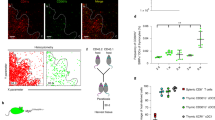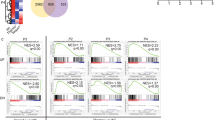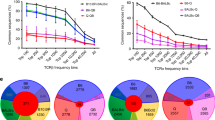Abstract
How T cell receptor (TCR) avidity influences CD8+ T cell development and repertoire selection is not yet fully understood. To fill this gap, we utilized Src-like adaptor protein (SLAP)-deficient mice as a tool to increase TCR avidity on double positive (DP) thymocytes. We generated SLAP−/− mice with the transgenic MHC class I-restricted TCR (OT-1) and SLAP−/− Vβ5 mice, expressing only the β-chain of the TCR OT-1 transgene, to examine the effects of increased TCR surface levels on CD8+ T cell development and repertoire selection. In comparing SLAP−/− OT-1 and Vβ5 mice with wild-type controls, we performed compositional analysis and assessed thymocyte signaling by measuring CD5 levels. In addition, we performed tetramer and compositional staining to measure affinity for the cognate antigen, ovalbumin (OVA) peptide, presented by MHC. Furthermore, we quantified differences in α-chain repertoire in SLAP−/− Vβ5 mice. We have found that SLAP−/− OT-1 mice have fewer CD8+ thymocytes but have increased CD5 expression. SLAP−/− OT-1 mice have fewer DP thymocytes expressing Vα2, signifying increased endogenous α-chain rearrangement, and more non-OVA-specific CD8+ splenocytes upon tetramer staining. Our data demonstrate that SLAP−/− Vβ5 mice also have fewer OVA-specific cells and increased Vα2 usage in the peripheral Vβ5 CD8+ T cells that were non-OVA-specific, demonstrating differences in α-chain repertoire. These studies provide direct evidence that increased TCR avidity in DP thymocytes enhances CD8+ T cell negative selection deleting thymocytes with specificity for cognate antigen, an antigen the mature T cells may never encounter. Collectively, these studies provide new insights into how TCR avidity during CD8+ T cell development influences repertoire selection.







Similar content being viewed by others
References
Jameson SC, Bevan MJ. T-cell selection. Curr Opin Immunol. 1998;10(2):214–9.
Marrack P, Hannum C, Harris M, Haskins K, Kubo R, Pigeon M, Shimonkevitz R, White J, Kappler J. Antigen-specific, major histocompatibility complex-restricted T cell receptors. Immunol Rev. 1983;76:131–45.
Morris GP, Allen PM. How the TCR balances sensitivity and specificity for the recognition of self and pathogens. Nat Immunol. 2012;13(2):121–8.
Anderton SM, Wraith DC. Selection and fine-tuning of the autoimmune T-cell repertoire. Nat Rev Immunol. 2002;2(7):487–98.
Takahama Y, Nitta T, Mat Ripen A, Nitta S, Murata S, Tanaka K. Role of thymic cortex-specific self-peptides in positive selection of T cells. Semin Immunol. 2010;22(5):287–93.
Fink PJ, McMahan CJ. Lymphocytes rearrange, edit and revise their antigen receptors to be useful yet safe. Immunol Today. 2000;21(11):561–6.
Sosinowski T, Killeen N, Weiss A. The Src-like adaptor protein downregulates the T cell receptor on CD4+CD8+ thymocytes and regulates positive selection. Immunity. 2001;15(3):457–66.
Dragone LL, Shaw LA, Myers MD, Weiss A. SLAP, a regulator of immunoreceptor ubiquitination, signaling and trafficking. Immunol Rev. 2009;232(1):218–28.
Myers MD, Dragone LL, Weiss A. Src-like adaptor protein down-regulates T cell receptor (TCR)-CD3 expression by targeting TCR zeta for degradation. J Cell Biol. 2005;170(2):285–94.
Myers MD, Sosinowski T, Dragone LL, White C, Band H, Gu H, Weiss A. Src-like adaptor protein regulates TCR expression on thymocytes by linking the ubiquitin ligase c-Cbl to the TCR complex. Nat Immunol. 2006;7(1):57–66.
Peterson LK, Shaw LA, Joetham A, Sakaguchi S, Gelfand EW, Dragone LL. SLAP deficiency enhances number and function of regulatory T cells preventing chronic autoimmune arthritis in SKG mice. J Immunol. 2011;186(4):2273–81.
Watanabe N, Arase H, Onodera M, Ohashi PS, Saito T. The quantity of TCR signal determines positive selection and lineage commitment of T cells. J Immunol. 2000;165(11):6252–61.
Mariathasan S, Zakarian A, Bouchard D, Michie AM, Zúñiga-Pflücker JC, Ohashi PS. Duration and strength of extracellular signal-regulated kinase signals are altered during positive versus negative thymocyte selection. J Immunol. 2001;167(9):4966–73.
Hogquist KA, Jameson SC, Heath WR, Howard JL, Bevan MJ, Carbone FR. T cell receptor antagonist peptides induce positive selection. Cell. 1994;76(1):17–27.
Fink PJ, Swan K, Turk G, Moore MW, Carbone FR. Both intrathymic and peripheral selection modulate the differential expression of V beta 5 among CD4+ and CD8+ T cells. J Exp Med. 1992;176(6):1733–8.
Dillon SR, Jameson SC, Fink PJ. V beta 5+ T cell receptors skew toward OVA+H-2Kb recognition. J Immunol. 1994;81(3):1790–801.
Dragone LL, Myers MD, White C, Sosinowski T, Weiss A. SRC-like adaptor protein regulates B cell development and function. J Immunol. 2006;176(1):335–45.
Dragone LL, Myers MD, White C, Gadwal S, Sosinowski T, Gu H, Weiss A. Src-like adaptor protein (SLAP) regulates B cell receptor levels in a c-Cbl-dependent manner. Proc Natl Acad Sci USA. 2006;103(48):18202–7.
Kedl RM, Rees WA, Hildeman DA, Schaefer B, Mitchell T, Kappler J, Marrack P. T cells compete for access to antigen-bearing antigen-presenting cells. J Exp Med. 2000;192(8):1105–13.
Gallegos AM, Bevan MJ. Central tolerance to tissue-specific antigens mediated by direct and indirect antigen presentation. J Exp Med. 2004;200(8):1039–49.
Boursalian TE, Fink PJ. Mutation in Fas ligand impairs maturation of thymocytes bearing moderate affinity T cell receptors. J Exp Med. 2003;198(2):349–60.
Azzam HS, Grinberg A, Lui K, Shen H, Shores W, Love PE. CD5 expression is developmentally regulated by T cell receptor (TCR) signals and TCR avidity. J Exp Med. 1998;188(12):2301–11.
Clarke SR, Barnden M, Kurts C, Carbone FR, Miller JF, Heath WR. Characterization of the ovalbumin-specific TCR transgenic line OT-I: MHC elements for positive and negative selection. Immunol Cell Biol. 2000;72(2):110–7.
McGargill MA, Derbinski JM, Hogquist KA. Receptor editing in developing T cells. Nat Immunol. 2000;1(4):336–41.
Naramura M, Kole HK, Hu RJ, Gu H. Altered thymic positive selection and intracellular signals in Cbl-deficient mice. Proc Natl Acad Sci USA. 1998;95(26):15547–52.
Nakayama T, Singer A, Hsi ED, Samelson LE. Intrathymic signalling in immature CD4+CD8+ thymocytes results in tyrosine phosphorylation of the T-cell receptor zeta chain. Nature. 1989;341(6243):651–4.
van Oers NS, Killeen N, Weiss A. ZAP-70 is constitutively associated with tyrosine-phosphorylated TCR zeta in murine thymocytes and lymph node T cells. Immunity. 1994;1(8):675–85.
van Oers NS, Killeen N, Weiss A. Lck regulates the tyrosine phosphorylation of the T cell receptor subunits and ZAP-70 in murine thymocytes. J Exp Med. 1996;183(3):1053–62.
van Oers NS, Love PE, Shores EW, Weiss A. Regulation of TCR signal transduction in murine thymocytes by multiple TCR zeta-chain signaling motifs. J Immunol. 1998;160(1):163–70.
Mingueneau M, Sansoni A, Gregoire C, Roncagalli R, Aguado E, Weiss A, Malissen M, Malissen B. The proline-rich sequence of CD3epsilon controls T cell antigen receptor expression on and signaling potency in preselection CD4+CD8+ thymocytes. Nat Immunol. 2008;9(5):522–32.
Szymczak AL, Workman CJ, Gil D, Dilioglou S, Vignali KM, Palmer E, Vignali DA. The CD3epsilon proline-rich sequence, and its interaction with Nck, is not required for T cell development and function. J Immunol. 2005;175(1):270–5.
Tailor P, Tsai S, Shameli A, Serra P, Wang J, Robbins S, Nagata M, Szymczak-Workman AL, Vignali DA, Santamaria P. The proline-rich sequence of CD3epsilon as an amplifier of low-avidity TCR signaling. J Immunol. 2008;181(1):243–55.
Ouchida R, Yamasaki S, Hikida M, Masuda K, Kawamura K, Wada A, Mochizuki S, Tagawa M, Sakamoto A, Hatano M, Tokuhisa T, Koseki H, Saito T, Kurosaki T, Wang JY. A lysosomal protein negatively regulates surface T cell antigen receptor expression by promoting CD3zeta-chain degradation. Immunity. 2008;29(1):33–43.
Wang H, Holst J, Woo SR, Guy C, Bettini M, Wang Y, Shafer A, Naramura M, Mingueneau M, Dragone LL, Hayes SM, Malissen B, Band H, Vignali DA. Tonic ubiquitylation controls T-cell receptor: CD3 complex expression during T-cell development. EMBO J. 2010;29(7):1285–98.
Sakaguchi N, Takahashi T, Hata H, Nomura T, Tagami T, Yamazaki S, Sakihama T, Matsutani T, Negishi I, Nakatsuru S, Sakaguchi S. Altered thymic T-cell selection due to a mutation of the ZAP-70 gene causes autoimmune arthritis in mice. Nature. 2003;426(6965):454–60.
Sebzda E, Mariathasan S, Ohteki T, Jones R, Bachmann MF, Ohashi PS. Selection of the T cell repertoire. Annu Rev Immunol. 1999;17:829–74.
Hogquist KA, Tomlinson AJ, Kieper WC, McGargill MA, Hart MC, Naylor S, Jameson SC. Identification of a naturally occurring ligand for thymic positive selection. Immunity. 1997;6(4):389–99.
Scott-Browne JP, White J, Kappler JW, Gapin L, Marrack P. Germline-encoded amino acids in the alphabeta T-cell receptor control thymic selection. Nature. 2009;458(7241):1043–6.
Huseby ES, White J, Crawford F, Vass T, Becker D, Pinilla C, Marrack P, Kappler JW. How the T cell repertoire becomes peptide and MHC specific. Cell. 2005;122(2):246–60.
Acknowledgments
The authors thank E. Treacy for technical assistance and P. Marrack for critical reading of the manuscript. The authors also thank Pamela Fink for generously donating B6 Vβ5 mice. This work was supported by an NIH T32 Grant AI07405 (S.F.F.), an Easton M. Crawford Charitable Lead Unitrust Postdoctoral Fellowship (L.K.P.), and a Within Our Reach grant from the American College of Rheumatology (L.L.D.).
Conflict of interest
The authors have no conflicting financial interest.
Author information
Authors and Affiliations
Corresponding author
Rights and permissions
About this article
Cite this article
Friend, S.F., Peterson, L.K., Kedl, R.M. et al. SLAP deficiency increases TCR avidity leading to altered repertoire and negative selection of cognate antigen-specific CD8+ T cells. Immunol Res 55, 116–124 (2013). https://doi.org/10.1007/s12026-012-8354-y
Published:
Issue Date:
DOI: https://doi.org/10.1007/s12026-012-8354-y




